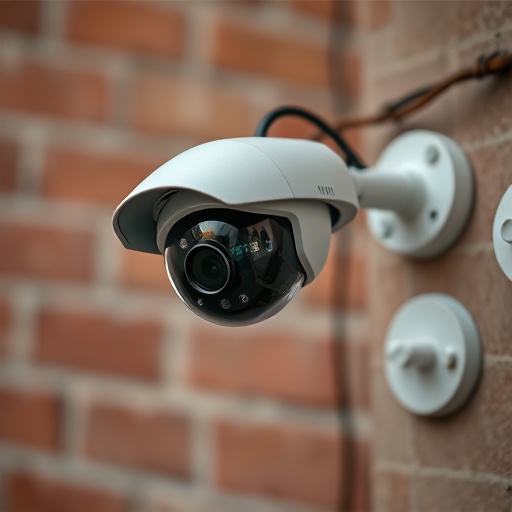Install an outdoor dummy camera by selecting a visible location, charging the battery, securing mounting hardware, and strategically placing the camera for optimal coverage. Ensure clear visibility, test functionality, use durable mounts, maintain regular testing, and check for loose connections to deter intruders effectively.
“Uncover the power of deterrence with battery-operated fake security cameras, a smart and cost-effective way to enhance home security. This comprehensive guide walks you through the essential steps for successful outdoor dummy camera installation. From understanding these devices’ mechanics to choosing the ideal location, preparing your camera for placement, and testing its integrity, each phase is designed to maximize their effectiveness as deterrents. Follow our expert advice on Outdoor Dummy Camera Installation Steps for peace of mind.”
- Understanding Battery-Operated Fake Security Cameras
- Choosing the Right Outdoor Location for Installation
- Preparing the Dummy Camera for Placement
- Mounting and Securing the Fake Camera Firmly
- Testing and Maintaining Your Outdoor Dummy Camera
Understanding Battery-Operated Fake Security Cameras
Battery-operated fake security cameras, also known as outdoor dummy cameras, are a popular choice for homeowners looking to enhance their home security without the hassle of complex wiring. These innovative devices offer a simple and effective solution by running on rechargeable batteries, eliminating the need for power outlets. Installation is typically straightforward, involving just a few simple steps. First, choose a location with optimal visibility, such as a window or door, and ensure it’s easily accessible for monitoring. Second, carefully remove the camera from its packaging and charge the built-in battery to full capacity. Then, attach the camera securely using the provided mounting hardware, aligning it precisely for maximum coverage.
Choosing the Right Outdoor Location for Installation
When installing a battery-operated fake security camera outdoors, selecting the ideal location is key for effective surveillance and deterrence. Consider areas with high visibility, such as entry points, driveways, or open spaces, to maximize its impact. The spot should offer clear line-of-sight without significant obstructions like trees or buildings that could block the camera’s view. Ensure it’s securely mounted on a sturdy structure or pole to withstand outdoor conditions and prevent damage or theft.
Follow these Outdoor Dummy Camera Installation Steps: first, assess the area for optimal visibility and accessibility; second, choose a location high enough to capture a wide area but also strategically positioned to avoid detection from nearby windows or passersby; third, securely attach the camera to a solid surface using screws or brackets designed for outdoor use; finally, test its functionality and ensure it’s powered by reliable batteries capable of lasting through varying weather conditions.
Preparing the Dummy Camera for Placement
Before installing your battery-operated outdoor dummy camera, there are a few preparation steps to ensure optimal positioning and effectiveness. Start by thoroughly charging the device using the included USB cable; this ensures it has ample power for continuous operation. Next, locate the ideal spot for placement—a high, visible area that offers clear line-of-sight of the target area. This could be on a fence, a tree, or even a pole specifically designed for security cameras. Ensure the camera is firmly attached and secure to prevent it from being easily moved or damaged.
Once positioned, test its functionality, including motion detection and night vision capabilities, to ensure it operates as expected. Adjust any settings if necessary, such as sensitivity levels and recording quality. Proper preparation guarantees that your outdoor dummy camera will serve its purpose effectively, providing a powerful deterrent to potential intruders while offering peace of mind for the homeowner.
Mounting and Securing the Fake Camera Firmly
When installing an outdoor dummy camera, ensuring it’s securely fastened is paramount. Begin by selecting a sturdy mount that can withstand various weather conditions. Attach the camera to the mount using the provided hardware, tightening all screws securely. Position the camera at a strategic location offering optimal visibility, often on a pole or wall. Use tools like drill bits and levelers for precise placement.
For added security, consider burying a portion of the mock camera’s base in concrete, especially in areas prone to tampering. This reinforces its stability and deterrence factor. Remember, a firmly mounted fake security camera sends a strong message to potential intruders, acting as an effective deterrent without the need for real surveillance equipment.
Testing and Maintaining Your Outdoor Dummy Camera
Testing your outdoor dummy camera regularly is crucial for ensuring it remains effective as a deterrent. After the initial installation, take a moment to test its functionality—make sure the camera moves and rotates as expected, capturing clear images or videos in varying lighting conditions. This step is key in identifying any technical glitches early on.
Maintaining your outdoor dummy camera involves keeping it clean and properly secured. Periodically wipe down the camera lens with a microfiber cloth to prevent dust buildup, which can impair its vision. Additionally, ensure the camera is firmly mounted to withstand outdoor elements. Regular checks for loose connections will also help maintain optimal performance, ensuring these battery-operated security devices serve their purpose effectively for an extended period.
Battery-operated fake security cameras, or outdoor dummy cameras, offer a cost-effective way to enhance your home’s security without the hassle of complex wiring. By following these simple installation steps—from selecting the ideal location to testing and maintenance—you can effectively deter potential intruders while adding an extra layer of peace of mind. Remember, while these cameras act as a deterrent, real security comes from combining them with robust physical security measures and professional monitoring systems.
